英语广告中的双关及其翻译文献综述revised
- 格式:docx
- 大小:178.46 KB
- 文档页数:5
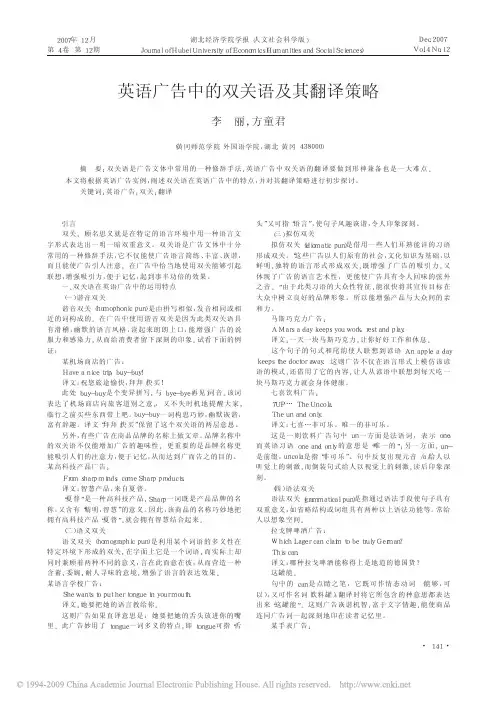
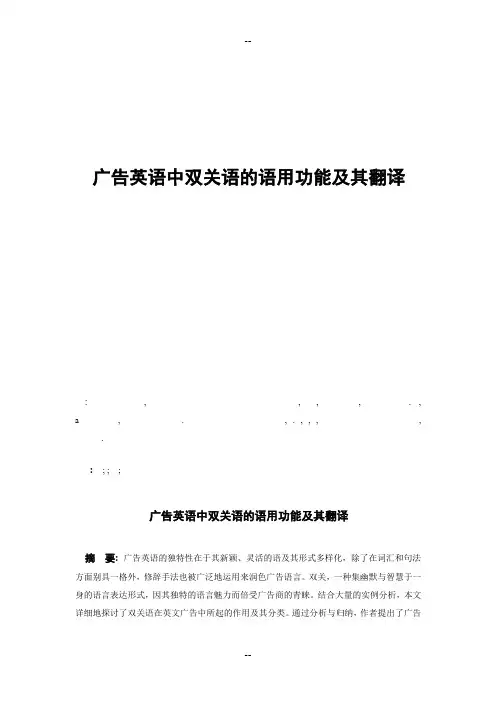
广告英语中双关语的语用功能及其翻译: , , , , . , a , . , . , , , ,.: ; ; ;广告英语中双关语的语用功能及其翻译摘要: 广告英语的独特性在于其新颖、灵活的语及其形式多样化,除了在词汇和句法方面别具一格外,修辞手法也被广泛地运用来润色广告语言。
双关,一种集幽默与智慧于一身的语言表达形式,因其独特的语言魅力而倍受广告商的青睐。
结合大量的实例分析,本文详细地探讨了双关语在英文广告中所起的作用及其分类。
通过分析与归纳,作者提出了广告双关语翻译的五种策略:保留、再造、补偿、解释说明以及省略不译。
译者在翻译过程中可以选择一种或者多种策略以达到译文的最佳关联。
关键词:广告;双关语;语用功能;翻译( ): , . a ’ a . , . : “ , , a , , , ; .”, . , , a , , ., , , . , . “ a ” [1]. A ( ) a , .a , . — , , , . . .海量英语论文尽在英语论文网,免费下载网址:需要其他类型英语论文可以咨询25377173511. 1, . , , . a : “ –( )”., “ a , ”. , “ a , , a ”. , “Aa a ”. , , , .1. 21. 2. 1“ , . , a . , .”, :“ . .”. “” ’ , . . , .“ ’t . . .”. “” “ a ”, ”. , , . , , .1. 2. 2“ , , , . , . , . , .”:“ ‘’ ”“”. , “ ”, , , “ ”. , a . “’ ’ .“ . 5000 .”. a . “” “” a . a .“ ! 100% $40”. s a . “ ” , . “ ” “ ”. : a , . , , a .“ .”a . , . , . . . . , .1. 2. 3“ a , , , ”[2]. , , .a , . , . . a .a . , , . , . .“A a , .”. , : “ a ” “ a ”. , a ’ a a ( ) ( ).“ , ’ .”a . “” : – a . “ ”a . . . , . ?“ .”, , a . “”, a , “”, , a , “ ”. .1. 2. 4, . , .“ ? .”. “” a . , a “” —. “” . , a .“” .“ .”, “ ” , (; , ) ( ). . , .1. 2. 5A , , . . , . : “50%.”a 2001 . a , . , a , 50%. , ’ .“ .”() ( ) . a “V” . “V” .a . , . , .海量英语论文尽在英语论文网,免费下载网址:需要其他类型英语论文可以咨询2537717352a , , . a a . .2. 1, , ’ . , a , a .“ a … a … a .”“” : , , . , . , , . , , . , .“ !”a a —. , , , “ ”. , “” “”, , “ ”. :f ; . . ’ .2. 2. a . , , , . , . A a . ’ . , a . .“ .”. “” “”. , ‘”. . “” “” .“ .”. “”, , “” “” “”. “” . .2. 3 ’sA a , . . , , , ’s . :“ a .”. “”a ’ : , . , . , ’ .2. 4 —, , . a . . ? :“, , , ’t . . , . , , , .. . . , . , , . , , . . , , , ”[3].a , , ’ a . :“ , ’s a .”, “ , ’s a ” . , “” , . , . , .“ , .”. “” “”, . , . , , , . , , , “ , ”. . .“ .”.“” : , . . , . , . ’s .2. 5. . :“ .”a . “ ”. , “ ” ” ”, . :“ ;.”. “” : . ’t , . .2. 6, . a ’s , .“A a .”, “” : . : a ; , a . ’ .“ .”a . , . “” “”. ’s , a . , . ’t , .3, , . , , ,[4]. , , . , , . , . ,a : , . . ; ., . , , , . , , , , . . , .3. 1, ., . , , a ,, . , , , ., ( ) . . .A: 电脑选苹果,烦恼远离我。
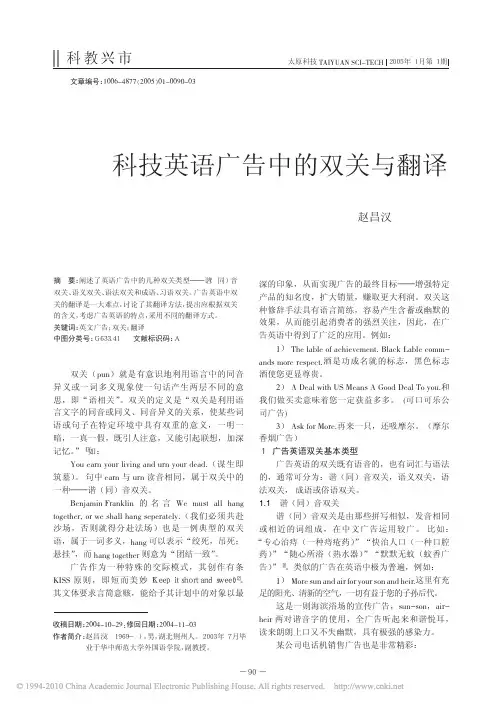
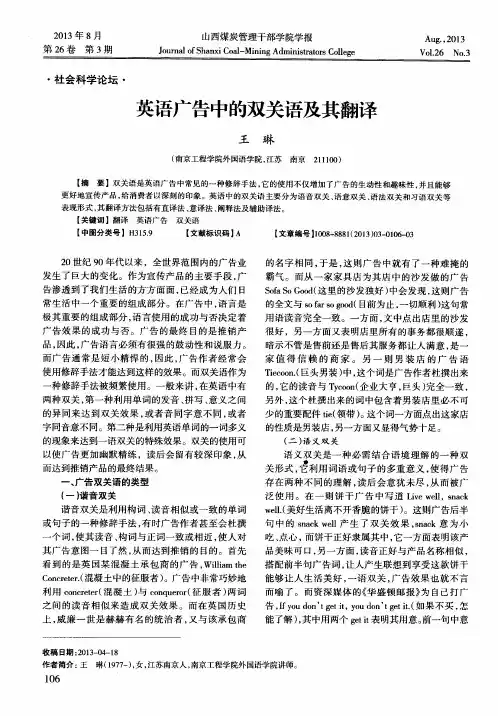
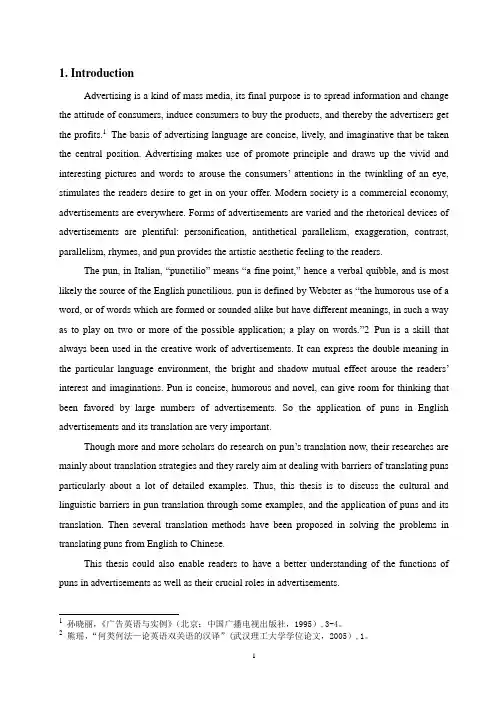
1. IntroductionAdvertising is a kind of mass media, its final purpose is to spread information and change the attitude of consumers, induce consumers to buy the products, and thereby the advertisers get the profits.1The basis of advertising language are concise, lively, and imaginative that be taken the central position. Advertising makes use of promote principle and draws up the vivid and interesting pictures and words to arouse the consumers’ attention s in the twinkling of an eye, stimulates the readers desire to get in on your offer. Modern society is a commercial economy, advertisements are everywhere. Forms of advertisements are varied and the rhetorical devices of advertisements are plentiful: personification, antithetical parallelism, exaggeration, contrast, parallelism, rhymes, and pun provides the artistic aesthetic feeling to the readers.The pun, in Italian, “punctilio” means “a fine point,” hence a verbal quibble, and is most likely the source of the English punctilious. pun is defined by Webste r as “the humorous use of a word, or of words which are formed or sounded alike but have different meanings, in such a way as to play on two or more of the possible application; a play on words.”2 Pun is a skill that always been used in the creative work of advertisements. It can express the double meaning in the particular language environment, the bright and shadow mutual effect arouse the readers’interest and imaginations. Pun is concise, humorous and novel, can give room for thinking that been favored by large numbers of advertisements. So the application of puns in English advertisements and its translation are very important.Though more and more scholars do research on pun’s translation now, their researches are mainly about translation strategies and they rarely aim at dealing with barriers of translating puns particularly about a lot of detailed examples. Thus, this thesis is to discuss the cultural and linguistic barriers in pun translation through some examples, and the application of puns and its translation. Then several translation methods have been proposed in solving the problems in translating puns from English to Chinese.This thesis could also enable readers to have a better understanding of the functions of puns in advertisements as well as their crucial roles in advertisements.1孙晓丽,《广告英语与实例》(北京:中国广播电视出版社,1995),3-4。
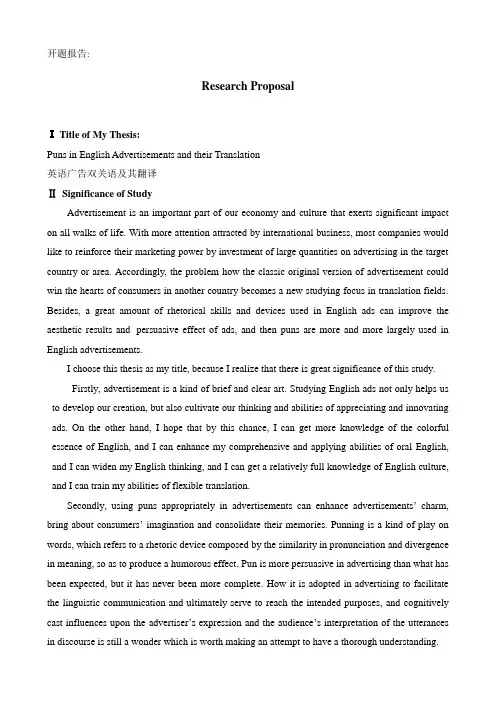
开题报告:Research ProposalⅠ Title of My Thesis:Puns in English Advertisements and their Translation英语广告双关语及其翻译ⅡSignificance of StudyAdvertisement is an important part of our economy and culture that exerts significant impact on all walks of life. With more attention attracted by international business, most companies would like to reinforce their marketing power by investment of large quantities on advertising in the target country or area. Accordingly, the problem how the classic original version of advertisement could win the hearts of consumers in another country becomes a new studying focus in translation fields. Besides, a great amount of rhetorical skills and devices used in English ads can improve the aesthetic results and persuasive effect of ads, and then puns are more and more largely used in English advertisements.I choose this thesis as my title, because I realize that there is great significance of this study.Firstly, advertisement is a kind of brief and clear art. Studying English ads not only helps us to develop our creation, but also cultivate our thinking and abilities of appreciating and innovating ads. On the other hand, I hope that by this chance, I can get more knowledge of the colorful essence of English, and I can enhance my comprehensive and applying abilities of oral English, and I can widen my English thinking, and I can get a relatively full knowledge of English culture, and I can train my abilities of flexible translation.Secondly, using puns appropriately in advertisements can enhance advertisements’charm, bring about consumers’ imagination and consolidate their memories. Punning is a kind of play on words, which refers to a rhetoric device composed by the similarity in pronunciation and divergence in meaning, so as to produce a humorous effect. Pun is more persuasive in advertising than what has been expected, but it has never been more complete. How it is adopted in advertising to facilitate the linguistic communication and ultimately serve to reach the intended purposes, and cognitively cast influences upon the advertiser’s expression and the audience’s interpretation of the utterances in discourse is still a wonder which is worth making an attempt to have a thorough understanding.Thirdly, the study of punning in advertising may be of practical importance in that it is likely to provide guidelines for advertisers on how to employ advertising puns more forcefully. It leads us to achieve a better understanding of puns in advertising and thus enjoy them.In conclusion, rhetoric, especially punning, is an art of language, and its effect can be exerted only by faithful and vivid translation. Thus, to study translation of puns in English advertisements is of importance.ⅢLiterature ReviewMcQuarrie discussed puns in advertising broadly, as a play or twist within an advertisement’s structure that serves to produce an echo or multiplication of meaning. For example, a recent advertisement shows men’s ties, arranged to form a bouquet, with the headlines: forget me knots. Another example, this for Bucks cigarettes, shows a cigarette pack with a picture of a stag, “Herd of These?”Based on Mcquarrie (Mcquarrie: 1996), the process of constructing a resonant advertisement is straightforward.Tanaka (1994) discusses covert communication in the advertising and the inferential process of puns and metaphors. According to Tanaka, covert communication became one of the strategies the advertiser uses to make the audience “believe something about a product without her trusting in him, or indeed, despite her distrusting him”. Generally speaking, it has two advantages: (a) the audience may get a kind of pleasure out of processing some information; (b) more deeply involved in the process of interpreting, the audience pays more attention to the product advertised and shares a larger part of responsibility in recovering the advertiser’s meaning; accordingly, the advertiser advertiser can avoid taking certain responsibility for issues that are socially loaded. In their own words, “covert communication manipulates trigger to which the human mind is highly susceptible.”Puns, as Tanaka states, are an effective way of attracting the audience’s attention, for it conveys two meanings for the price of one word. It is true that in some cases the initial meaning of the puns is either rejected or just helping to obtain additional contextual effects the speaker intends. By denying initial meaning and creating unexpected consequences, they attract more attention and give the audience more psychological satisfaction. Undoubtedly, Tanaka has noticed the significance of contextual effect and the great role, which cognitive factors play in the advertiser makes in producing an advertisement; it is mostly on that to avoid social responsibility. She pays more attention to the cognitive factors than to the contextual effects, trying to survey the socially loaded aspect of the advertisers’ consideration. Tanaka does not explicitly address the question of how themass-media aspects of advertising affect Sperber and Wilson’s model, based as it is mainly on examples of one-to-one oral, linguistic, synchronic communication taking place in one spot.Working within the tradition of rhetorical analysis, most Chinese scholars focus on expressive effect of advertising puns. They all make use of many examples to illustrate how puns can contribute to advertising communication.Besides making a classification, Chen Changlai (Chen: 1994) concludes that the use of puns is the effort to meet the audience’s psychological needs; aesthetic needs and needs for good luck.Peng jiayu (peng: 1999) regards advertising puns as a form of art and employs a variety of examples to tell people how to enjoy them.Huang lei (huang: 2000) studies puns in Chinese and English advertisements by employing a variety of examples. He adopts a comparative method to investigate into the use and some negative effect of puns in Chinese and English advertising.Xue bing and li yue’s (2000) explore some characteristics peculiar to puns and their function in the context of advertising, with particular stress exerted on the pragmatic and aesthetic perspectives.Concerning puns in advertising language, li ruihe (li: 2001) focuses on the classification and functions and effect of puns. The paper states that advertisers prefer puns because puns contain profound cultural connotations which can activate the audience’s aesthetic enjoyment and desire for the advertised product.Meng lin and Zhan jinhui’s(meng and zhan:2001) paper is about the techniques of puns and the translation of puns in English advertisements. There are various ways to form puns in advertisements. The translation of puns in advertisements is difficult because one must keep both the double meanings of a pun and the style of the advertisement in mind.Articles collected in this field are scattered in magazines concerning rhetorical devices. Since most of them provide only simple generalizations at the superficial level, there will be just brief mentioning and commenting. In general, the research is lacking in a theoretical basis. Nevertheless, it may be helpful and illuminating for researchers who want to conduct further research.ⅣKey PointsIn my paper, the title of my thesis is puns in English advertisements and its translation. Obviously, my key points of this are studying punning and its translating strategies in English advertisements. I will discuss two main points in my paper. The first one is the application of punsin English advertisements. In this point, I will introduce five concepts: homophonic puns, semantic puns, idiomatic puns, grammatical puns, mimetic puns. The other one is the translation of puns in English advertisements. I will bring in five strategies of translating puns in English advertisements: corresponding translation, separating translation, emphasizing translation, and compensating translation.ⅤOutline1 Language Characteristics of English Advertisements1.1 Lexical Features1.2 Syntactical Features1.3 Discourse Features1.3.1 Body Copy of an Advertisement1.3.2 Differences in Body Copies1.4 Rhetorical Features2 A Brief Introduction to Punning2.1 Definition of a Pun2.2 Classification of Puns3 Applications of Puns in English Advertisements3.1 Homophonic Puns3.2 Semantic Puns3.3 Idiomatic Puns3.4 Grammatical Puns3.5 Mimetic Puns4 The Translation of Puns in English Advertisements4.1Corresponding Translation4.2 Separating Translation4.3 Emphasizing Translation4.4 Compensating TranslationⅥBibliography[1] Augarde Tony. The Oxford Guide to Word Game.Oxford: Oxford University Press, 1984,pp.67-98.[2] Chesterman Andrew(ed). Readings in Translation Theory [C]. Helsinki: Oy Finn Lectura Ab,1989, pp54-96.[3] Cook G. The discourse of advertising. London: Routledge, 1992, pp.24-58.[4] Jan de Waard & Eugene A. Nida. From One Language to Another. New York: ThomasNelson Publishers, 1986, pp.89-123.[5] Leech,G. N. English in Advertising [M]. London: Longman.1966, pp.48-114.[6] Nash, W. Rhetoric: The Wit of Persuasion, Oxford: Basil Blackwell. 1989, pp.81-109.[7] Newmark, Peter. A Textbook of Translation. Shanghai: Shanghai Foreign Language andEducation Press, 2001, pp.56-98[8] 陈文伯. “一词两义的翻译”, (中国翻译) 第4期23-25 1994[9] 侯维瑞. 英语语体[M] 上海: 上海外语教育出版社,1999[10] 孟琳. 英语广告中双关语的运用技巧及翻译[J] 中国翻译,2001,(5)[11] 余立三. 英汉修辞比较与翻译[M] 北京商务印书馆1985[12] 张南峰, “Delabastita的双关语翻译理论在英汉翻译中的应用”, <中国翻译> 第1期:30-36,2003[13] 赵静. 广告英语[M] 北京外语教学与研究出版社,1994,10[14] 蒋柳. 英语双关语的认知研究广西大学学报哲学科学版,2007,(z2)[15] 沈晓维. 英语广告双关语的译法探讨科教文汇,2008,(23)ⅦSchedule of Writing2008.6~2008.7: Complete all the preparative work, including proposal for selecting the theme;literature research and translation;2008.8~2008.9: Complete my research proposal and reading-notes.2008.9~2008.10: Complete the first draft;2008.12~2009.1: Complete the second draft;2009.2~2009.3: Complete the final form;2009.3~2009.4: Typing, oral presentation, form filling.。
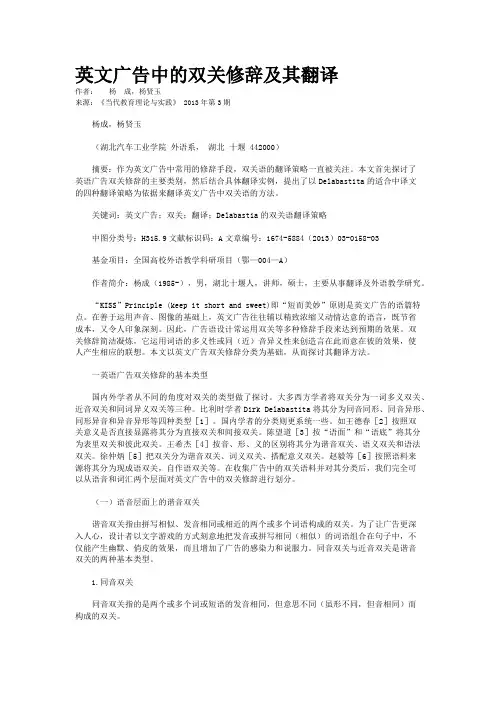
英文广告中的双关修辞及其翻译作者:杨成,杨贤玉来源:《当代教育理论与实践》 2013年第3期杨成,杨贤玉(湖北汽车工业学院外语系,湖北十堰 442000)摘要:作为英文广告中常用的修辞手段,双关语的翻译策略一直被关注。
本文首先探讨了英语广告双关修辞的主要类别,然后结合具体翻译实例,提出了以Delabastita的适合中译文的四种翻译策略为依据来翻译英文广告中双关语的方法。
关键词:英文广告;双关;翻译;Delabastia的双关语翻译策略中图分类号:H315.9文献标识码:A文章编号:1674-5884(2013)03-0158-03基金项目:全国高校外语教学科研项目(鄂—004—A)作者简介:杨成(1985-),男,湖北十堰人,讲师,硕士,主要从事翻译及外语教学研究。
“KISS”Principle (keep it short and sweet)即“短而美妙”原则是英文广告的语篇特点。
在善于运用声音、图像的基础上,英文广告往往辅以精致浓缩又动情达意的语言,既节省成本,又令人印象深刻。
因此,广告语设计常运用双关等多种修辞手段来达到预期的效果。
双关修辞简洁凝炼,它运用词语的多义性或同(近)音异义性来创造言在此而意在彼的效果,使人产生相应的联想。
本文以英文广告双关修辞分类为基础,从而探讨其翻译方法。
一英语广告双关修辞的基本类型国内外学者从不同的角度对双关的类型做了探讨。
大多西方学者将双关分为一词多义双关、近音双关和同词异义双关等三种。
比利时学者Dirk Delabastita将其分为同音同形、同音异形、同形异音和异音异形等四种类型[1]。
国内学者的分类则更系统一些。
如王德春[2]按照双关意义是否直接显露将其分为直接双关和间接双关。
陈望道[3]按“语面”和“语底”将其分为表里双关和彼此双关。
王希杰[4]按音、形、义的区别将其分为谐音双关、语义双关和语法双关。
徐仲炳[5]把双关分为谐音双关、词义双关、搭配意义双关。
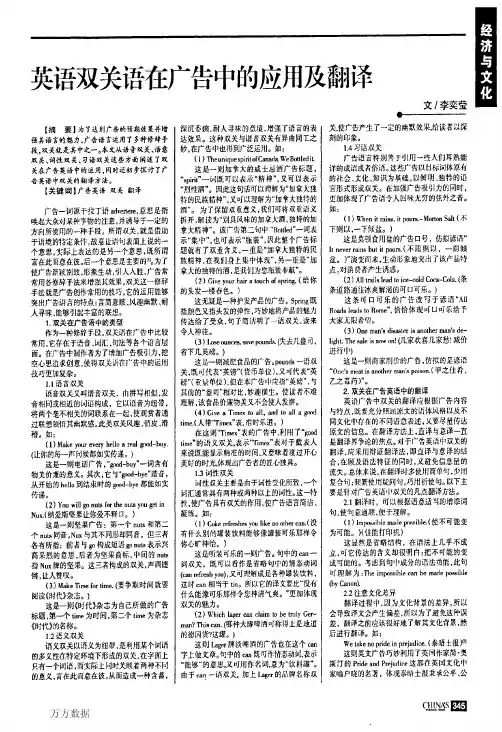
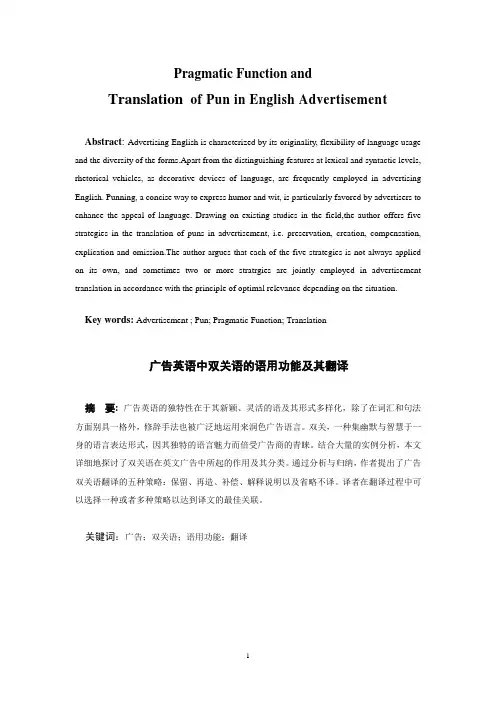
Pragmatic Function andTranslation of Pun in English Advertisemen tAbstract: Advertising English is characterized by its originality, flexibility of language usage and the diversity of the forms.Apart from the distinguishing features at lexical and syntactic levels, rhetorical vehicles, as decorative devices of language, are frequently employed in advertising English. Punning, a concise way to express humor and wit, is particularly favored by advertisers to enhance the appeal of language. Drawing on existing studies in the field,the author offers five strategies in the translation of puns in advertisement, i.e. preservation, creation, compensation, explication and omission.The author argues that each of the five strategies is not always applied on its own, and sometimes two or more stratrgies are jointly employed in advertisement translation in accordance with the principle of optimal relevance depending on the situation.Key words: Advertisement; Pun; Pragmatic Function; Translation广告英语中双关语的语用功能及其翻译摘要: 广告英语的独特性在于其新颖、灵活的语及其形式多样化,除了在词汇和句法方面别具一格外,修辞手法也被广泛地运用来润色广告语言。
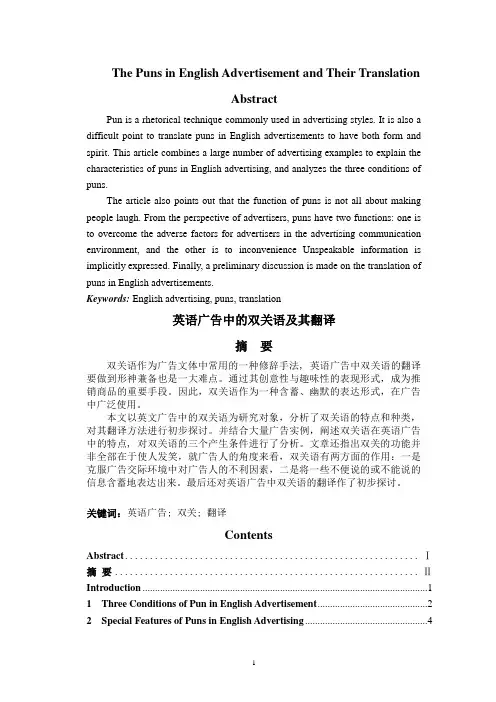
The Puns in English Advertisement and Their TranslationAbstractPun is a rhetorical technique commonly used in advertising styles. It is also a difficult point to translate puns in English advertisements to have both form and spirit. This article combines a large number of advertising examples to explain the characteristics of puns in English advertising, and analyzes the three conditions of puns.The article also points out that the function of puns is not all about making people laugh. From the perspective of advertisers, puns have two functions: one is to overcome the adverse factors for advertisers in the advertising communication environment, and the other is to inconvenience Unspeakable information is implicitly expressed. Finally, a preliminary discussion is made on the translation of puns in English advertisements.Keywords: English advertising, puns, translation英语广告中的双关语及其翻译摘要双关语作为广告文体中常用的一种修辞手法, 英语广告中双关语的翻译要做到形神兼备也是一大难点。
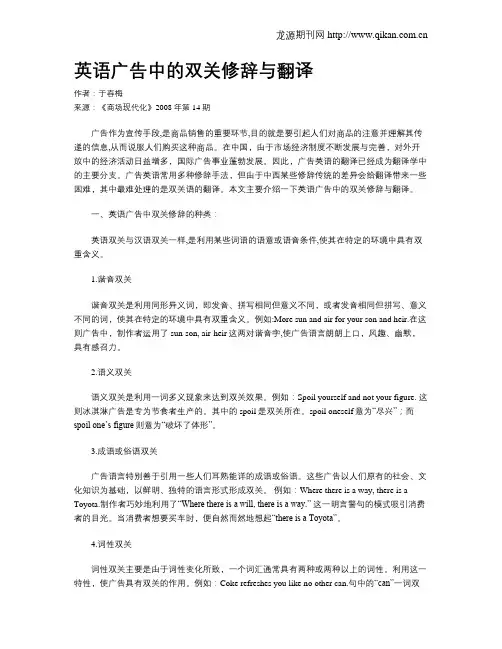
英语广告中的双关修辞与翻译作者:于春梅来源:《商场现代化》2008年第14期广告作为宣传手段,是商品销售的重要环节,目的就是要引起人们对商品的注意并理解其传递的信息,从而说服人们购买这种商品。
在中国,由于市场经济制度不断发展与完善,对外开放中的经济活动日益增多,国际广告事业蓬勃发展。
因此,广告英语的翻译已经成为翻译学中的主要分支。
广告英语常用多种修辞手法,但由于中西某些修辞传统的差异会给翻译带来一些困难,其中最难处理的是双关语的翻译。
本文主要介绍一下英语广告中的双关修辞与翻译。
一、英语广告中双关修辞的种类:英语双关与汉语双关一样,是利用某些词语的语意或语音条件,使其在特定的环境中具有双重含义。
1.谐音双关谐音双关是利用同形异义词,即发音、拼写相同但意义不同,或者发音相同但拼写、意义不同的词,使其在特定的环境中具有双重含义。
例如:More sun and air for your son and heir.在这则广告中,制作者运用了sun-son, air-heir这两对谐音字,使广告语言朗朗上口,风趣、幽默,具有感召力。
2.语义双关语义双关是利用一词多义现象来达到双关效果。
例如:Spoil yourself and not your figure. 这则冰淇淋广告是专为节食者生产的。
其中的spoil是双关所在。
spoil oneself意为“尽兴”;而spoil one’s figure则意为“破坏了体形”。
3.成语或俗语双关广告语言特别善于引用一些人们耳熟能详的成语或俗语。
这些广告以人们原有的社会、文化知识为基础,以鲜明、独特的语言形式形成双关。
例如:Where there is a way, there is a Toyota.制作者巧妙地利用了“Where there is a will, there is a way.” 这一明言警句的模式吸引消费者的目光。
当消费者想要买车时,便自然而然地想起“there is a Toyota”。
本文部分内容来自网络整理,本司不为其真实性负责,如有异议或侵权请及时联系,本司将立即删除!== 本文为word格式,下载后可方便编辑和修改! ==广告英语中双关语的运用及翻译摘要:双关语是英语广告中一种较为常见的修辞手段。
双关语的翻译本身就是一个难点,而广告中双关语的翻译则更加复杂。
英语中的双关语主要分为语音双关、语意双关、语法双关和成语、俗语双关等表现形式。
从双关语的双重含义及广告语体风格考虑,双关语的汉译可以采用分别表义法、套译法、侧重译法和补偿译法等方法。
关键词:英语广告;双关语;翻译一、引言现代商品经济社会,广告几乎无处不在。
广告形式千姿百态,广告创意千变万化。
广告语言是广告的语言文字要素,是实现广告目的的主要手段。
它要利用推销原理写出雅俗共赏、生动有趣的文字,要具有特殊的感染力,能在瞬间引起读者注意,刺激其购买欲望,最终促成购买行为。
双关语这一修辞手段是广告创作常用的技巧。
双关,顾名思义,就是在特定的语言环境中用一种语言文字形式表达出一明一暗双重意义,既引人注意,又能引起联想。
双关语具有简洁凝练,风趣幽默,新颖别致等修辞效果,能够突出广告的特点,因而在广告中得到大量应用。
二、广告双关语的类型作为一种修辞手段,双关语在广告中比较常用,它存在于语音、词汇、句法等各个语言层面。
在广告中,广告制作者为了增加广告的吸引力,挖空心思地追求新的创意,使得双关语在广告中的运用技巧更加纷繁复杂。
巧妙的双关能使语言含蓄、幽默、生动、给人以回味和想象的余地。
较为常见的如下:1.谐音双关谐音双关是用拼写相似,发音相同或相近的词构成的。
广告制作者非常乐于使用谐音双关,因为此类双关具有风趣、幽默、俏皮、滑稽的语言风格,能增强广告的说服力和感染力,从而给消费者留下深刻的印象。
(1)GoodbuyWinter!100%Cotton Knitwear $40这是一则冬季服装削价出售的广告。
从字面上看,是指物美价廉的一桩划算的好买卖。
英语广告中双关语的运用及翻译
一、双关语是什么
双关语(Double entendre)是指在一个句子中,意思同时可以读出
两种意思,其中一种意思常常带有有趣的影射和幽默的意味。
双关语的最
大特点就是在一句话中包含两种意思,其中有一种意思是直接表达的,而
另一种意思是潜台词,它们之间并不存在联系,但是从字面上理解后,就
可以发现双关语的存在。
二、双关语在英语广告中的运用
1、具有幽默性
双关语在英语宣传广告中常常带有一定的幽默性,它可以激发观众的
共鸣,同时也可以让观众记住品牌,而且让观众的情绪也跟着提升。
比如,可口可乐宣传口号“Open happiness”,直译:“打开快乐”,双关语的
寓意就在于:通过喝可乐来获得幸福快乐。
2、引起兴趣
双关语以其新颖别致,抑扬顿挫的编排,含蓄深刻,具有极强的触发
性和诱因,可谓无人不识。
双关语的运用,能很好地吸引观众的眼球,让
他们对这款产品有兴趣,因此很多大型品牌在宣传时也常常会用到双关语
的技巧来激发大家的共鸣,比如说,微软的宣传语“Where do y ou want
to go today?”,直译:“今天你想去哪里?”这里强调不仅仅是今天,
而是用几个词来激发你的兴趣,以及可以到达的地方可以有多特别,即使
有极大的空间来探索,可以让观众有更多的想象空间。
广告英语中双关语的运用及翻译的论文外语翻译论文摘要广告英语作为一种应用语言,它有着自己独特的语言风格和特点。
广告英语用词优美独到,句法洗练而内涵丰富,修辞变化多端,耐人寻味。
广告是以最简单的语言表达最复杂的意义,语言的魅力在广告中得到最充分的展示,广告的目的在于打动人心,激发人们的购买欲望,一字一句都要能充分发挥它的“魅力”和产品想要达到的商业目的。
因此,广告制作者挖空心思地追求新的创意,使得双关语在广告中的运用技巧更加纷繁复杂。
巧妙的双关能使语言含蓄、幽默、生动、机智,起到旁敲侧击,借题发挥的作用,能够很好地突出广告的特点,因而在广告中得到大量应用。
而双关作为一种修辞手法,常用于广告中,它存在于语言、词汇、句法等方面。
本文从谐音双关,语义双关,词性双关和仿拟双关几个方面对双关语在英语广告中的运用作了阐述;同时也从分别表义法,套译法,侧重译法和补偿译法等几种翻译方法对英语广告双关语作了些探讨。
关键词:广告英语;双关语;翻译abstractas an applied language, advertising english has its own linguistic style and features. its language is original and beautiful and full of connotations. its sentence structure is succinct. advertisements, giving the charm of languagefull play, use the simplest language to express the most complex meanings. the purpose of advertisements is to stimulate people’s desire for shopping. therefore, manufacturers try their best to use puns to create new meanings. the skillful use of puns makes advertising language vivid and humorous .many kinds of rhetorical devices are used in advertisements. and punning is one of the most frequently used ways in advertising language to help to achieve desired effects of advertisements. this paper explores punning and the translation of puns in english advertisements. it deals with various ways to form puns, and thetechniques of translating puns in advertisements.key words: advertising english; pun; translation随着国际分工的深化、发展和全球经济一体化的趋势日益加强,国际间的商品流通日益频繁,各个国家为了争夺世界市场,竞相推销本国产品。
英文广告双关语篇一:英语广告中的双关语abstract:nowadays,advertisementshavebecomeanindispensiblepartofourlif ethatitcomestoourviewalmostomnipresent.itsinfluencesareintangible.itisan artofconcentrated,integrated.inordertomakefulluseoftheadvertisement,rhet oricaldeviceshavebeenputintouse,especiallythepuns.Therearemainlyfourfo rmsofpuns:homophonicpuns,homographicpuns,grammaticalpuns,andparo dypuns.Thepunshavetheirowndistinctivefunctionsothattheyaresignificanti nmakingadvertisement.Thisarticlefocusesonthepuninadvertisingandthefun ctionoftheuseofpunstogivesomeanalysis.Keywords:advertisement,puns,form,functionintroduction Thepurposeofadvertisingistoattracttheaimedcustomers.agreatimpressionsh ouldbegivenbytheuniqueadoptionofwordsandsuccinctandcontent-richsynt axoftheadvertisements.asforEnglishadvertisement,itshouldhavetheeffectof inducingthecustomer’simagination,arisingthedesireofpurchaseandcatchingeyes.asuccessfuladve rtisingnotonlyjustshockpeoplewithvisual,auditoryeffects,butalsopassedbypeoplebecauseoftheconc iseness.(:英文广告双关语)amonganumberofrhetoricaldevices,ofwhichthemostpopular,isthepun.in thewebster’sThirdnewinternationaldictionary,itdefinesthepuninsuchway:thehumorous useofawordinsuchawayastosuggestdifferentmeaningsorapplicationsofwor dshavingthesameornearlythesamesoundbutdifferentmeanings;aplayonwor ds.(Yan,20XX)所谓“双关”,《现代汉语词典》(1993)的解释是“用词造句时表面上是一个意思,而暗中隐藏着另一个意思”。
英语商业广告中双关语的翻译双关语在广告的具体功能业独特,除了产生最佳的语境效果外,也获得了最大的经济效益。
本文着眼于分析英汉翻译中的双关语的处理方法。
标签:商业广告双关语翻译在经济全球化和商品市场化的今天,外国的商业广告也纷纷涌入中国。
在国际市场推销商品,借助大众传媒应运而生的商务广告起到不可或缺的作用。
一个成功的商务广告的翻译,可以吸引异国的目标消费者,激发其购买欲望,从而达到推销商品的最终目的。
一、商业广告中的双关语英语Advertisement(广告)源于拉丁语, 原义为“唤起大众对某种事物的注意,并诱于一定的方向所使用的一种手段。
”广告制作者非常乐于使用谐音双关,因为此类双关具有风趣、幽默、俏皮、滑稽的语言风格,能增强广告的说服力和感染力,从而给消费者留下深刻的印象。
商业广告是一门艺术,而商广告的翻译也是一门学问,要达到理想的翻译效果,首先对其翻译的特点进行分析。
英汉中的双关语(pun),运用同音异义或是同形异义的形式使句子具有几种不同的含意“谐音双关是用拼写相似,发音相同或相近的词构成的” 。
双关语表里双涉,一举两得,富于联想,灵活机动,深刻而生动地揭示广告产品的特性与功能广告语常用修辞手法,为了使表述内容形象化、具体化或使主要词语鲜明、突出,加强语言效果,引起公众注意并帮助公众记忆。
二、广告中双关语的翻译双关语的一层意义译出后,另外一层意义也很重要,但却无法同时译出,这时,可采用一些补偿手段加以弥补。
对于广告来说,这些补偿手段主要指承载广告的媒体,如电视的图像、广播的声音及报纸的版式设计等。
一则关于面包的商业广告是这样写的:“She is the nimblest girl around. Nimble is the way she goes. Nimble is the way she eats. Light, delicious and nimble.”面包的名字叫Nimble.牛津高阶字典这样解释nimble: able to move quickly and easily with light neat movements. (聪慧敏捷).在翻译的时候, 就要适度地展开联想, 认识到广告本意在于暗示人们食用健康的nimble面包可以使人变得行动敏捷,思想活跃。
英语广告中的双关及其翻译文献综述r e v i s e d精编版MQS system office room 【MQS16H-TTMS2A-MQSS8Q8-MQSH16898】本科毕业设计(论文)文献综述( 2011 届 )题目:英语广告中的双关及其翻译Punning in English Advertisements and Translation分院:外国语分院专业:英语班级:07英语本1姓名:朱蕾学号:指导老师:郑敏完成日期:2010年11月英语广告中的双关及其翻译的文献综述前言随着全球化经济的不断进步,市场及消费者对于商家企业的要求也越来越趋于全面。
因此,各企业为了能在激烈的竞争中存活下来,不断推出新型营销策略,而广告正是最有效最直接的方式之一。
在这广告如林的时代,为能突显自己的广告,彰显自己的品牌,商家不断推出新颖独特的广告宣传语,而“双关语”恰是其中的佼佼者。
一.该选题在国内外的研究现状:1)国外研究现状一个广告成功与否可以用AIDMA心理效应(Attention, Interest, Desire, Memory, Action)(冯翠华,2005:100)作为判断依据,即广告是否成功地抓住眼球,激发兴趣,勾起消费欲,方便记忆和促使消费行为。
这也就决定了英语广告的一些基本语言特征。
在词汇方面,英语广告喜欢通过使用褒义形容词,选用简短的动词,妙用人称代词或运用大量的复合词等手法使广告拥有强烈的针对性,抓住消费者的眼球。
而在句子方面,更倾向于运用短词或短语代替整句话,即使运用了长句,也都是以祈使句为主。
总体而言,广告作为一种特别的实用性语体,在其措辞,语法以及修辞方式等方面有其新颖,独特之处(张建:1995:75-76),双关更是广告英语常用的修辞手法。
笔者查阅了“双关”在牛津英语词典(OED)中的的记载,Pun作为修辞手法最早由John Dryden 使用,早在2000多年前,亚里士多德就在其《修辞学》中提的双关语的应用。
英语广告中的双关及其翻
译文献综述r e v i s e d The Standardization Office was revised on the afternoon of December 13, 2020
本科毕业设计(论文)文献综述
( 2011 届 )
题目:
英语广告中的双关及其翻译Punning in English Advertisements and Translation
分院:外国语分院
专业:英语
班级:07英语本1
姓名:朱蕾
学号:
指导老师:
郑敏
完成日期:2010年11月
英语广告中的双关及其翻译的文献综述
前言
随着全球化经济的不断进步,市场及消费者对于商家企业的要求也越来越趋于全面。
因此,各企业为了能在激烈的竞争中存活下来,不断推出新型营销策略,而广告正是最有效最直接的方式之一。
在这广告如林的时代,为能突显自己的广告,彰显自己的品牌,商家不断推出新颖独特的广告宣传语,而“双关语”恰是其中的佼佼者。
一.该选题在国内外的研究现状:
1)国外研究现状
一个广告成功与否可以用AIDMA心理效应(Attention, Interest, Desire, Memory, Action)(冯翠华,2005:100)作为判断依据,即广告是否成功地抓住眼球,激发兴趣,勾起消费欲,方便记忆和促使消费行为。
这也就决定了英语广告的一些基本语言特征。
在词汇方面,英语广告喜欢通过使用褒义形容词,选用简短的动词,妙用人称代词或运用大量的复合词等手法使广告拥有强烈的针对性,抓住消费者的眼球。
而在句子方面,更倾向于运用短词或短语代替整句话,即使运用了长
句,也都是以祈使句为主。
总体而言,广告作为一种特别的实用性语体,在其措辞,语法以及修辞方式等方面有其新颖,独特之处(张建:1995:75-76),双关更是广告英语常用的修辞手法。
笔者查阅了“双关”在牛津英语词典(OED)中的的记载,Pun作为修辞手法最早由John Dryden 使用,早在2000多年前,亚里士多德就在其《修辞学》中提的双关语的应用。
涉及不同类别的双关语的各种文字游戏在修辞学中统称为“Pun”(西方文体学辞典,2004:265)。
比利时学者Delabastita把双关分为四大类型,分别是同音同形(homonymy),同音异形(homophony),异音同形(homography)和异音异形(paronymy),而后又将每个类型分为垂直双关语,即两层意思同时出现;和水平双关语,即两层意思分开出现。
Delabastita的双关语翻译理论也为翻译双关提供了便捷,有助于研究某个译者或某种文化的翻译观和文学观。
Delabastita的分类法并没有很强的语言特殊性,这也就意味着这套理论不仅仅适用于英文与欧洲各种语言的互通翻译,也适合于中英之间的互译现象(Delabastita 1987:145-146)。
美国学者Archibald A. Hill则提出双关语的三个条件,即双重语境(Double context)、绞链(Hinge)和触机(Trigger)(李鑫华,2000:195)。
绞链即双关词,双关意义的连接点和轴心,专指在双关语中出现的能够同时关涉到双关的多重意义的语言表达形式。
触机则是作者使用双关语的动机背景,即说话人有意表露的意向。
双重语境则是双关语出现的客观前提,是铰链的双重意义所各自依附的语言环境。
没有绞链,双重语境就无法实现关联;双重语境是至关重要的因素,是绞链的双重意义赖以实现的基础。
广告作为一种特殊语言交际形式,通过明示话语对某种观念或产品进行宣传和推销,向大众传递相关信息,收信息大众借助常识等认知语境进行思辨,推理,从而理解广告的真正意义,最终形成促销的效果,因此广告的推理过程到广告效果的实现,都体现着关联理论的作用。
对广告信息的理解过程也就是寻找关联的过程(马丽 2010 4:174)。
关联理论由Sperber和Wilson在20世纪80年代提出。
其原则是,每一个明示的交际行为都应设想为这个交际行为本身具备最佳的关联性。
(何自然,冉永平,1998:95)
关联理论就为英语广告中的双关分析提供了一个良好的理论框架。
2) 国内研究现状
清华大学教授、博士生导师,兼任国家基础教育研究中心外语教育研究中心学术委员会主任、中国外语教学专业委员会学术委员会委员的崔刚教授在其着作《广告英语》中提到--双关语,是利用它干词语语音相同,语义不同的手段,使某些词语或者句子在特定的环境中具有双重的意义(崔刚,1993:46),形手段构成可译性障碍的又一例证;双关语利用异义,同音,异形构成“隐语”即“语义双关”而对于双关的翻译,由于语际转换只能在语义结构层实现对应,结果造成双关立意的丧失(刘宓庆 2003:110)。
然而学者张南峰则认为,假如认为必须保留原文双关语的结构和字面意义才算是翻译,那么就英汉翻译而言,双关语
的可译性就很低;但假如认为双关语不可译为相同的双关语,那么可译性就很高了。
如果我们认为最重要的是保留原文的修辞效果和语篇完整,而不一定要保留原文双关语的结果和两层意思,不一定要在完全对等的语篇位置上制造双关语,甚至可以改动上下文,以容纳译文的双关语,那么就能想出多种解决方法。
(张南峰:2003:30-36)
根据笔者搜集的资料研究,林华在其“英语广告双关语的理解和翻译技巧”中提出四种方法,即对译法,活译法,加注法及意译法。
而笔者认为陈春华,潘利锋在其“论广告中双关修辞的翻译”中将双关翻译技巧分为契合译法,分别表义法,套译法,侧重译法以及补偿译法是比较完整详细的。
二.发展趋势
随着经济的全球化,越来越多的商家企业都开始面向国际,面向世界,其广告用词的翻译以及广告语中双关的翻译一直受到学者的关注。
关联理论对广告英语中双关的翻译提供了认知角度的指导。
在广告英语双关翻译中,译者应尽可能地向不同语种之间的消费者传达相同有效的广告意图,同时又不能给目标语造成过多的推理困难,这正是关联理论指导下双关语翻译的目标。
因此,在关联理论指导下的双关翻译是当下广告语及其双关翻译的研究方向。
三.存在问题
国内很多学者都对双关的翻译理论和技巧做过研究和探讨,也提出了许多相关的技巧。
然而译者需要根据广告的内容特点,选择适合的表达方式,既要照顾原文的语体风格,又要尽量传达出原文的信息。
所以在许多双关信息在翻译中流失,。
之前的学者虽然对双关的形成及翻译策略做过研究和分析,但没有在某一个翻译理论指导下对翻译策略的采用进行分析,也没能就双关翻译提出指导策略。
四.作者拟解决问题
针对上述所提出的问题,笔者将在关联理论的框架下对英语广告中双关翻译的案例进行分析,以译文是否实现了双关的最佳关联,或足够接近最佳关联作为译文的评价标准,并分析归纳针对广告英语中双关语翻译的适当的技巧和策略。
参考文献
[1] 陈春华,潘利锋. 2007. 论广告中双关修辞的翻译[J]. 湖南工程学院学报. 1, 66-68
[2] 崔刚. 1993. 广告英语[M]. 北京:理工大学出版社
[3] 陈孝静,吴小龙,赵戈屏. 2008. 英文广告双关翻译与最佳关联[J]. 重庆科技学院学报. 3:159
[4] 林华. 2004. 英语广告双关语的理解和翻译技巧[J]. 江汉大学学报. 2:94-9
[5] 刘宓庆. 2003. 当代翻译理论[M]. 北京:中国对外翻译出版公司
[6] 李恬. 2009. 仿体对应和双关[J]. 外语研究,3:20
[7] 李鑫华. 2000. 英语修辞格详论[M]。
上海:上海外语教育出版社 195
[8] 马丽. 2010. 从关联理论看广告英语中的修辞手法[J]. 社科纵横 4:174
[9] 彭家玉,于少萍. 2001.英汉双管辞格比较研究[J] 山东外语教学. 1:28-29
[10] 冉永平,何自然 1998. 关联理论—认知语用学基础[J] 现代外语 95
[11] 伊诗文. 2010 从商业广告的问题特点看商务广告翻译[J]. 赤峰学院学报. 2:129
[12] 张建. 1995. 广告英语文体特点初探[J]. 上海外国语大学学报. 2:75-76
[13] 张南峰,2003. Delabastita的双关语翻译理论在英汉翻译中的应用[J] 中国翻译. 1:32-34
[14] 赵真华. 2006. 双关的英汉对比及其理据[J]. 外语与外国教学. 8:49。